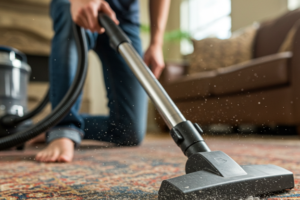
When it comes to home renovations, Americans spend over $500 billion each year, according to the Joint Center for Housing Studies of Harvard University. With such significant investments, homeowners are always looking for ways to restore and refresh their existing fixtures without the need for costly replacements.
Two popular options for surface restoration are refinishing and reglazing. Although these terms are often used interchangeably, they represent distinct processes with different methods, benefits, and outcomes.
Understanding these differences can help you choose the best option based on the condition, budget, and required results.
What Is Refinishing?
Refinishing is the process of repairing, sanding, and applying a new protective coating to a surface. This helps to restore its appearance and enhance its durability. The method is often chosen for surfaces like bathtubs, sinks, and countertops that show signs of wear, such as scratches or chips.
Refinishing allows homeowners to restore damaged fixtures without the expense of replacement. It typically involves cleaning, fixing cracks, and applying a durable finish that lasts for years.
According to a report, refinishing has one of the highest project cost recovery rates. In fact, hardwood floor refinishing can help recover 147% of the project costs. In comparison, new wood flooring can recover only 118% of the project cost, while new bathrooms and kitchen upgrades can recover far less. This showcases the cost-effective nature of refinishing compared to full replacements.
Benefits of Refinishing
Refinishing offers multiple advantages for homeowners. One of the primary advantages is cost savings. Instead of replacing a worn-out fixture, refinishing can restore it to like-new condition. All for a fraction of the price. This process can extend the lifespan of items like bathtubs and countertops for 10-15 years.
Additionally, refinishing is eco-friendly, reducing the need for wasteful disposal of old materials. It also saves time and reduces the disruption that comes with a full renovation, allowing homeowners to quickly return to their daily routine.
What Is Reglazing?
Reglazing is a surface restoration process that involves applying a fresh layer of enamel or specialized coating over a fixture. For example, a bathtub or sink. This method is often used to restore the appearance of a surface that has become worn, chipped, or discolored over time.
Unlike refinishing, reglazing focuses primarily on enhancing the surface’s appearance rather than addressing structural damage. It’s an effective solution for surfaces still in good condition but needs a cosmetic upgrade.
Benefits of Reglazing
Reglazing offers several advantages, especially for surfaces with minimal structural damage. First, it is a cost-effective option when compared to replacing entire fixtures. The process is quick, often completed within a few hours, minimizing disruption. Reglazed surfaces are also highly durable and resistant to stains, making them easier to clean and maintain.
Additionally, reglazing allows for a wide variety of color and finish options. So, you can customize the look of your fixtures to match your design preferences. Lastly, it is an eco-friendly option since it avoids the need for fixture replacement, reducing waste.
To learn more about the restoration and reglazing process, visit newfinishonline.com. The site provides expert insights into refinishing and reglazing for a variety of surfaces, including bathtubs, sinks, countertops, and more. Whether you’re looking to restore the original beauty of your bathtub or update your kitchen countertops, they can offer the right solution.
Key Differences Between Refinishing and Reglazing
Refinishing and reglazing may appear similar, but there are distinct differences between the two processes.
Process and Purpose
Refinishing involves repairing and resurfacing a fixture to restore its structural integrity. The process typically includes sanding, filling cracks or chips, and applying a new, durable coating to the surface. It is ideal for surfaces with significant wear or damage that require both cosmetic and structural improvements.
Reglazing focuses primarily on restoring the surface’s appearance. It involves applying a new layer of enamel or specialized coating over the existing surface. Reglazing is perfect for fixtures that are still in good condition but have become discolored, stained or have minor surface-level wear.
Time and Labor
Refinishing requires more time and effort because it involves repairing any cracks or chips before applying a new coating. This process can take several hours to even a complete day. It depends on the surface size and extent of the damage.
Reglazing is a faster process, typically taking only a few hours to complete. However, this can be subjective to what you want to reglaze, as some sophisticated pieces may take longer to do so.
For instance, the opening of Whitley Bay’s St Mary’s Lighthouse was delayed for reglazing a lantern. The lantern was concave, and manufacturing the same piece was taking longer than expected. Therefore, the North Tyneside Council announced that the opening will be delayed for around a month.
Suitable Surfaces
Refinishing is best for surfaces with damage like deep scratches, cracks, or chips. It can be used on bathtubs, sinks, and countertops that need both aesthetic restoration and structural repair.
Reglazing works well for fixtures that have minor imperfections or discoloration but do not require extensive repairs. It’s commonly used on bathtubs, sinks, and tiles that are structurally sound but need a fresh, shiny appearance.
Durability
Refinishing provides a longer-lasting result because it addresses both the appearance and integrity of the surface. A properly refinished fixture can last for 10-15 years with regular maintenance.
Reglazing provides a durable finish for cosmetic purposes but may not be as long-lasting as refinishing. While reglazed surfaces are resistant to stains and easy to clean, they may need reapplication after several years, especially with heavy use.
Cost
Refinishing tends to be more expensive because of the added labor and repairs involved. Structural repairs and sanding take longer and may require more materials. This leads to a higher overall cost in refinishing.
Reglazing is generally more affordable as it is a less intensive process that only involves a fresh coating. It is a quicker solution, reducing both labor and material costs. On average, bathtub refinishing and reglazing cost $480, including labor.
Frequently Asked Questions
What is the difference between refinishing and reglazing?
Refinishing involves repairing and resurfacing a fixture to restore both its appearance and structural integrity. Reglazing enhances the surface’s appearance by applying a fresh layer of enamel or coating, which is ideal for cosmetic upgrades without extensive repairs.
How long does refinishing or reglazing take?
Refinishing typically takes several hours to a full day, depending on the extent of damage and surface size. Reglazing is faster and usually completed within a few hours, as it requires less labor and no extensive repairs.
Can I reglaze or refinish all types of fixtures?
Both methods work well on common fixtures like bathtubs, sinks, and countertops. Refinishing is ideal for heavily damaged surfaces, while reglazing is best for those with minor wear or discoloration. Always consult with a professional for the best approach for your specific fixture.
Both refinishing and reglazing offer valuable solutions for restoring and renewing surfaces in your home. The right choice depends on the condition of the fixture and your desired results. Both methods are cost-effective and eco-friendly, helping extend the life of your fixtures. These benefits make them smart alternatives to expensive replacements.






